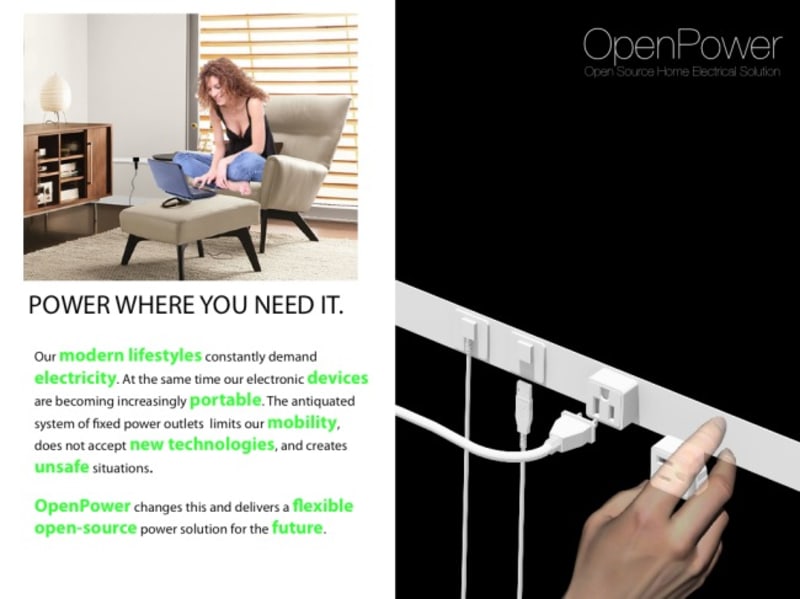Power where you need it.
Our modern lifestyles constantly demand electricity. At the same time our electronic devices are becoming increasingly portable. The antiquated system of fixed power outlets limits our mobility, does not accept new technologies, and creates unsafe situations.
OpenPower changes this and delivers a flexible open-source power solution for the future.
Currently many electrical devices often crowd one outlet. In the proposed system, electrical outlets are available where needed. This flexibility reduces cluttered outlets and eliminates the need for secondary electrical systems, such as extension cords or power strips. Safety of the electrical system is increased through the direct proximity of appliance to outlet and by not overloading the outlet.
This strategy allows the homeowner to place appliances and furniture wherever they want them. The idea is bring the power to your lifestyle, don’t alter your lifestyle to where the power is.
An open, non-fixed electrical system could increase efficiency in construction, interior flexibility, design aesthetics, and safety.
The concept is a continuous electrical hookup system that runs along the perimeter of rooms. Similar to a bus duct system, the user can connect to it at any location along its length. Outlets, data, wireless power, RF switches and other future modules can be plugged into the track system when and where required. If an outlet is not needed, simply remove it and place it in a drawer.
The system is designed to be integrated into existing building methods. The track design is a slim 1/8” deep, and is flush mounted on wall surfaces, therefore reducing electrical runs within wall cavities. Further development could allow the system to be pre installed recessed in gypsum board panels at the factory.
Wall switches no longer need to be hard-wired. Inexpensive technology has been around for a long time for switches that emit radio-frequency control to switched outlets and lighting fixtures. An iphone, ipad, or separate controller could be used to control all of the switches in a home.
The system is open and can allow the implementation of future unknown technologies, different standardized plugs (European, USB, etc.), and smart grid technology.
The open source power system is comprised of two primary components: Track and Modules.
The track is a linear system that is surface mounted on the wall. The top cavity of the extrusion contains a continuous magnetic emitter. Using wireless power technology, the emitter transfers electricity when it is in the vicinity of wireless power receiver. The closer the receiver is to the emitter, the more efficient the transfer of power is. Therefore power modules that are placed onto the system come into nearly direct contact with the magnetic emitter for maximum efficiency.
The modules are simply placed anywhere along the track, and are magnetically held in place by the magnets on the module and the track.
Re-thinking home electrical distribution with a proposal such as OpenPower will lead to more efficient use of our resources, increased safety, and a newer more sophisticated technology.
Like this entry?
-
About the Entrant
- Name:David Pollard
- Type of entry:individual
- Software used for this entry:Indesign, Revit Architecture, Sketchup
- Patent status:none








